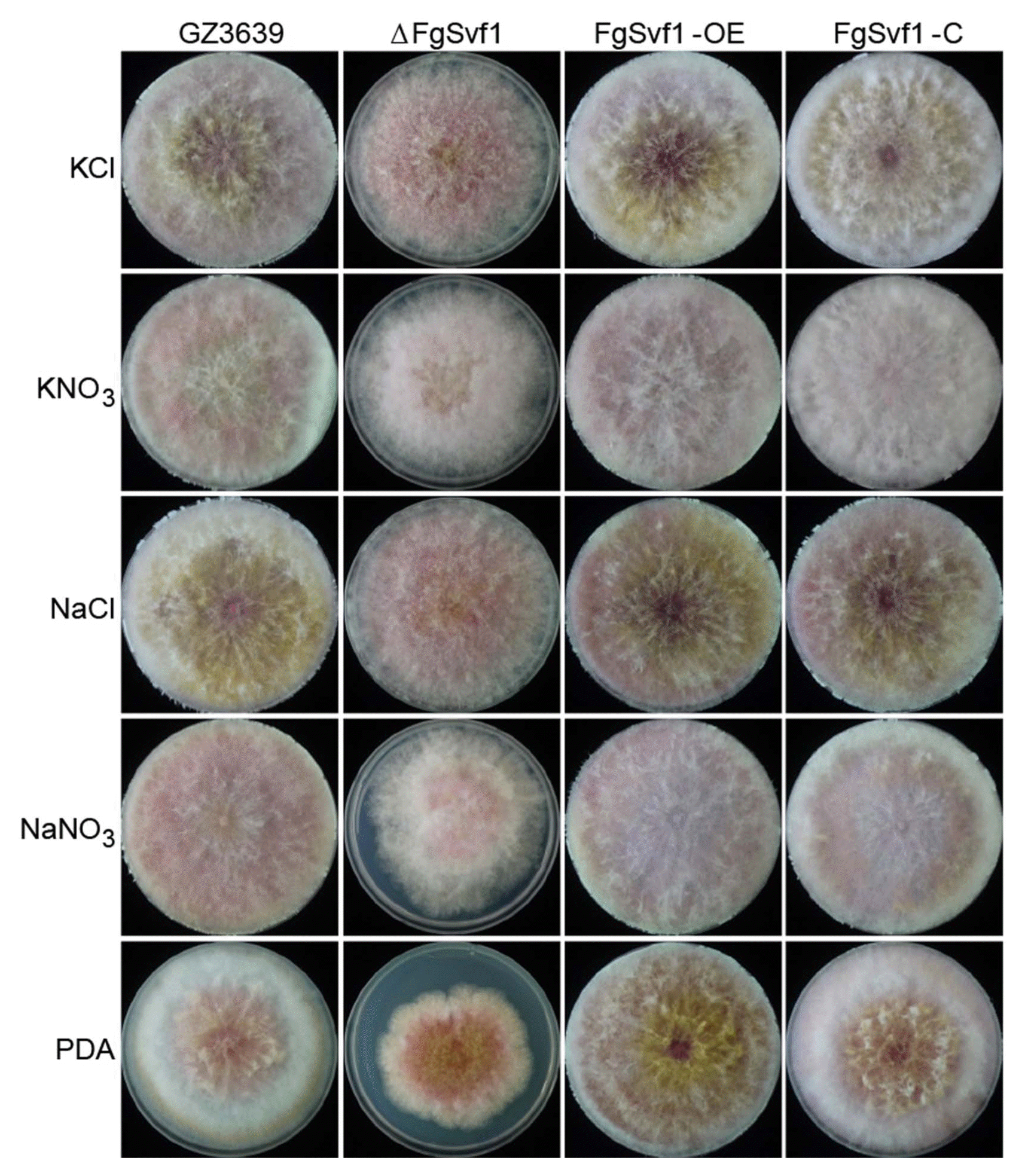Survival Factor Gene FgSvf1 Is Required for Normal Growth and Stress Resistance in Fusarium graminearum
Article information
Abstract
Survival factor 1 (Svf1) is a protein involved in cell survival pathways. In Saccharomyces cerevisiae, Svf1 is required for the diauxic growth shift and survival under stress conditions. In this study, we characterized the role of FgSvf1, the Svf1 homolog in the homothallic ascomycete fungus Fusarium graminearum. In the FgSvf1 deletion mutant, conidial germination was delayed, vegetative growth was reduced, and pathogenicity was completely abolished. Although the FgSvf1 deletion mutant produced perithecia, the normal maturation of ascospore was dismissed in deletion mutant. The FgSvf1 deletion mutant also showed reduced resistance to osmotic, fungicide, and cold stress and reduced sensitivity to oxidative stress when compared to the wild-type strain. In addition, we showed that FgSvf1 affects glycolysis, which results in the abnormal vegetative growth in the FgSvf1 deletion mutant. Further, intracellular reactive oxygen species (ROS) accumulated in the FgSvf1 deletion mutant, and this accumulated ROS might be related to the reduced sensitivity to oxidative stress and the reduced resistance to cold stress and fungicide stress. Overall, understanding the role of FgSvf1 in F. graminearum provides a new target to control F. graminearum infections in fields.
The homothallic ascomycete fungus Fusarium graminearum (teleomorph Gibberella zeae) is the major cause of Fusarium head blight (FHB) on cereal crops, including rice, barley, and wheat, worldwide. FHB leads to losses in grain yield and quality, and cereals with FHB are often contaminated with mycotoxins, such as trichothecenes and zearalenone, which can lead to mycotoxicoses in humans and livestock (Leslie et al., 2006). Despite the damage to production and food safety issues caused by FHB, sufficient chemical and biological strategies to control this fungus in fields have not been developed.
This fungus is highly diverse genetically and adaptable in nature. It reproduces conidia under favorable environmental conditions and reproduces ascospores during unfavorable conditions (Lee et al., 2011). FHB begins when F. graminearum spores land on the surfaces of host plant tissues. The spores germinate to form germ tubes that extend and develop into hypha, which directly penetrate plant surfaces within florets (Zhang et al., 2012). Recent evidence supports the role of reactive oxygen species (ROS), common by-products of aerobic respiration, in the regulation of spore germination. However, the accumulation of ROS has also been shown to induce destruction, such as cell apoptosis (Aguirre et al., 2005; Simon et al., 2000).
Apoptosis is a type of programmed cell death (PCD) in multicellular organisms, and it promotes differentiation and maintains homeostasis within mature tissues (Engelberg-Kulka et al., 2006; Green and Levine, 2014). Bcl-2 is a family of evolutionarily related proteins that regulate PCD by regulating mitochondrial physiology, mitochondria-dependent caspase activation (Vander Heiden and Thompson, 1999), and/or mitochondrial outer membrane permeability. Bcl-2 proteins can be pro-apoptotic (e.g., Bax, BAD, Bak, and Bok) or anti-apoptotic (e.g., Bcl-xL and Bcl-w). Apoptosis is also induced by other factors, such as growth factors and toxins (Wang et al., 1996).
Expression of anti-apoptotic proteins, such as Bcl-xL, promotes cell survival in response to genotoxic damage (Vander Heiden et al., 2002). Bcl-xL protects cells from apoptosis by specifically targeting the mitochondrial outer membrane (Kaufmann et al., 2003). A cell undergoing PCD loses the ability to utilize glucose via glycolysis, and although Bcl-xL cannot reverse this metabolic change, Bcl-xL allows cells to adapt to this change in cellular metabolism by facilitating the transport of metabolites across the outer mitochondrial membrane (Vander Heiden et al., 2000, 2001).
Bcl-xL has been analyzed in plants and humans, and although the unicellular eukaryote Saccharomyces cerevisiae does not contain any genes with a high sequence similarity to Bcl-xL, S. cerevisiae survival factor 1 (Svf1) functions similarly. Svf1 inhibits ROS generation and promotes survival under oxidative stress and cold stress (Brace et al., 2005). In addition, the loss of Svf1 in S. cerevisiae triggers a temperature-sensitive growth defect on a non-fermentable carbon source and affects the diauxic growth shift (Vander Heiden et al., 2002).
Survival factor 1 protein or survival factor 1-like proteins exist in many other fungal species, including Fusarium species (Choi et al., 2017; Sakamoto et al., 2009), but their functions have not been studied in filamentous fungi. In this study, we characterized the functions of the Svf1 ortholog in F. graminearum (FgSvf1 for F. graminearum Survival factor 1) genetically using deletion and overexpression strains. We characterized the phenotypic changes in vegetative growth, conidial germination, pathogenicity, and resistance to various stresses in these strains to determine the biological function of FgSvf1.
Materials and Methods
Fungal strains and culture conditions
The wild-type F. graminearum strain GZ3639 (Bowden and Leslie, 1999) and mutants derived from this were maintained in media according to the Fusarium laboratory manual (Leslie et al., 2006). Conidia was induced in carboxyl methyl cellulose (CMC) medium (Son et al., 2011), and fungal strains were cultivated on potato dextrose agar (PDA). All of the strains were stored as conidia suspensions in 20% glycerol at −80°C.
Construction of targeted gene deletion, overexpression, and complementation strains
For targeted gene deletion, overexpression, and complementation, a splitmarker recombination (SMR) strategy was used (Catlett et al., 2003). For gene deletion, the 5′ and 3′ flanking regions of the target gene were amplified by PCR using the primer pairs Del-5′F/Del-5′R and Del-3′F/Del-3′R based on the wild-type strain. A hygromycin-resistance cassette (HYG) was amplified from pIGPAPA (Horwitz et al., 1999). The 5′ flank, 3′ flank, and HYG amplicons were mixed at a molar ratio of 1:1:2, respectively, and were fused in a second PCR reaction. A third PCR reaction was performed using the nested primers, nestedF and nestedR, and this PCR product was transformed. For gene overexpression, HYG, elongation factor 1 alpha promoter (EFpro), and the 5′ and 3′ flanking regions of the target gene were amplified from pIGPAPA, pSYP100, and GZ3639, respectively, and the amplicons were fused by SMR as performed for construction of the overexpression mutant. The promoter of EFpro gene was amplified with primers EF1ap_F and EF1ap_R. The PCR product was cloned in pGEM-T easy (Promega, Madison, WI, USA). The nucleotide at position 6, 539, and 549 from EFpro were mutated to G, T, and G, respectively, to discard three restriction enzyme sites (KpnI, PstI, and XmnI) via site-directed mutagenesis using Quick-Change mutagenesis kit (Stratagene, La Jolla, CA, USA). The mutated EFpro was amplified with EF1ap_F_EcoRI and EF1ap_R_HindIII primers and cloned in pGEM-T easy, named pSYP100.
To complement the gene deletion, a DNA fragment carrying the promoter and open reading frame of FgSvf1 was fused with a geneticin resistance cassette (GEN) amplified with pII99 (Namiki et al., 2001), through SMR. All of the PCR primers used in this study are listed in Table 1. Transformants were screened by PCR to check whether they carried the desired deletion, overexpression, and complementation constructs.
Protoplast production and transformation
For conidia production, mycelial blocks of each strain were inoculated into CMC liquid medium and cultivated at 25°C for 5 days with shaking at 200 rpm. Conidia were incubated in 50 ml of YPG (10 g of peptone, 3 g of yeast extract, and 20 g of glucose per liter) with shaking at 200 rpm at 25°C for 12 h. Mycelia, which were harvested by filtration, were then incubated in 35 ml of 1 M NH4Cl containing 15 mg/ml driselase to generate protoplasts. The additional transformation steps were performed as described previously (Kim et al., 2006). Transformants carrying HYG or GEN were selected on regeneration medium (1 g of casein, 1 g of yeast extract, 342 g of sucrose, and 15 g of micro agar powder per liter) containing 75 μg/ml hygromycin or 75 μg/ml geneticin.
RNA extraction and quantitative real-time PCR
For confirming constructed mutant, each strain was cultivated in potato dextrose broth (PDB) medium for 3 days with constant shaking at 200 rpm at 25°C and for observing the transcript level of the gene involved in glycolysis, each strain was cultivated on PDA medium for 7 days at 25°C. Mycelia were harvested, ground under liquid nitrogen, and total RNA was extracted using the easy-spin Total RNA Extraction kit (iNtRON Biotechnology, Seongnam, Korea) according to the manufacturer’s instructions. To validate expression of FgSvf1 and genes involved in glycolysis, cDNAs were generated using the First Strand cDNA Synthesis Kit (TOYOBO Co., Ltd., Osaka, Japan) according to the manufacturer’s instructions. The cDNA samples were diluted to 10 ng/μl with distilled water, and 2 μl of cDNA template was used for each quantitative real-time PCR (qRT-PCR) reaction. The cDNA templates were mixed with 10 μl of SsoAdvaced Universal SYBR Green Supermix (Bio-Rad Laboratories Inc., Hercules, CA, USA), 7 μl of distilled water, and 0.5 μl of each primer (Table 2). The qRT-PCR protocol was 95°C for 5 min followed by 40 cycles of 95°C for 3 s, 60°C for 6 s, and 72°C for 21 s. The relative transcription levels were normalized to the reference gene cyclophilin (CYP).
Vegetative growth and observation of conidia
Each strain was cultivated on PDA, complete medium (CM), minimal medium, and yeast malt agar medium at 25°C for 4 days. The conidial germination test was performed for each strain as described previously (Hong et al., 2010) with slight modifications. Briefly, mycelial blocks cultivated on PDA for 3 days were inoculated in CMC and grown at 200 rpm at 25°C for 5 days. Conidia were harvested by centrifugation at 13,000 rpm at 4°C for 10 min, and then, 200 μl of spore suspension (1 × 105 conidia/ml) was incubated in 25 ml of PDB. The total number of conidia and the number of germinated conidia were counted 4, 8, and 12 h after inoculation by light microscopy. The germination rate (germinated conidia/total conidia) of each strain was compared using the post hoc Tukey test in the R program version 3.4.3.
Fertility test
Mycelia plugs were inoculated onto carrot agar plates and incubated at 25°C for 8 days in the dark for self-fertilization. The mycelia that grew on the plate were removed with 1 ml of 2.5% Tween-20, and then, the plates were incubated under near ultraviolet light (20 W, 500 lux) at 25°C for 10 days to induce sexual reproduction. Perithecia were dissected in a drop of 20% glycerol on a glass slide, and asci were flattened under the cover glass for microscopic observation (Min et al., 2010).
Virulence test
The virulence of each strain was determined on the wheat cultivar Eunpamil as described previously (Lee et al., 2009). In brief, 10 μl of a conidia suspension (1 × 105 conidia/ml in 0.1% Tween-20) was inoculated into a center spikelet of a wheat head at midanthesis stage. Spikelet exhibiting FHB symptoms were counted 14 days after inoculation. Virulence test was repeated three times with at least nine replicates per test.
Stress tests
The fungicide resistance test was performed as previously described (Jiang et al., 2011; Qin et al., 2015) with slight modifications. Briefly, mycelia plugs were inoculated onto PDA supplemented with 0.1–0.5 mg/l prochloraz fungicide and incubated at 25°C for 7 days. For the osmotic stress test, mycelia plugs were inoculated onto PDA plates supplemented with 0.2–1.8 M NaCl and incubated at 25°C for 7 days then the colony diameter of each strain was measured (Gu et al., 2015). All data were obtained from three replicates. For the cold test, conidia suspensions (103 conidia/ml) were stored at 4°C for 1–4 days in distilled water then 100 μl of each suspension was spread onto PDA (Son et al., 2012), and the numbers of germinated spore were counted after 3 days. All data were obtained from five replicates. For the oxidative stress test, each strain was incubated on PDA supplemented with 1–5 mM H2O2 at 25°C for 3 days.
Effect of salt and the carbon source on vegetative growth
To investigate the influence of salt on vegetative growth of FgSvf1 mutant strains, the wild-type GZ3639, the deletion mutants (ΔFgSvf1), the overexpression mutant (FgSvf1-OE), and the complementation strain (FgSvf1-C) were inoculated onto PDA supplemented with 0.2 M NaCl, NaNO3, KCl, and KNO3. PDA without additional salts was used as the control medium. All of the strains were cultivated at 25°C for 7 days, and then mycelial growth was evaluated.
To investigate the relationship between FgSvf1 and glycolysis, the vegetative growth of each strain was observed on CM supplemented with 30 g/l glucose, 30 ml/l glycerol, or 30 ml/l olive oil as the carbon source. CM without an additional carbon source was used as the control medium. All of the strains were cultivated at 25°C for 7 days, and then vegetative growth was evaluated.
Quantitation of PEP and intracellular ROS
The level of phosphoenolpyruvate (PEP) in each strain was determined using the PEP Colorimetric/Fluorometric Assay Kit (BioVision Inc., Milpitas, CA, USA) according to the manufacturer’s instructions. In brief, each strain was cultivated on PDA medium for 7 days at 25°C. After that, the mycelia was gathered and ground under liquid nitrogen then dry in freeze drier (Ilshinbiobase Co. Ltd., Dongducheon, Korea). After 2 days, 0.02 g of each sample were used for determining the level of PEP in each strain. Experiment was repeated twice with 5 replicates.
The level of intracellular ROS in each strain was determined using the OxiSelectTM Intracellular ROS Assay Kit (Cell Biolabs, Inc., San Diego, CA, USA) according to the manufacturer’s instructions with modifications. In brief, 3-day-old mycelia were removed from PDA plates and were washed twice with phosphate buffered saline. The mycelia were then incubated with dichloro-dihydro-fluorescein diacetate for 40 min at 37°C and washed twice. Finally, the mycelia were incubated in lysis buffer for 5 min, and fluorescence at 480 nm (excitation) and 530 nm (emission) was measured using a Spectramax Gemini XPS plate reader (Molecular Devices, Sunnyvale, CA, USA). Intracellular ROS concentration of each strain was normalized to the amount of DNA in each strain. PEP and intracellular ROS levels were compared using the post hoc Tukey test in the R program version 3.4.3, respectively.
Results
Targeted gene deletion, overexpression, and complementation of FgSvf1
The Svf1 orthologue, FgSvf1 (FGSG_05072) gene sequences was acquired from NCBI database (https://www.ncbi.nlm.nih.gov) using SVF1 protein sequence of S. cerevisiae. FgSvf1 contains 2,005 base pairs with three introns and is predicted to encode a protein with 377 amino acids. Phylogenetic analysis showed that survival factors are highly conserved in Ascomycota (Fig. 1A).

The phylogenetic tree of the FgSvf1 protein and FgSvf1 mutant construction. (A) The phylogenetic tree of FgSvf1 homologs in several fungal species is shown. The alignment was performed with ClustalW, and the MEGA program version 7.0 was used to perform a 1,000-bootstrap phylogenetic analysis using the neighbor joining method. (B) FgSvf1 targeted gene deletion, overexpression, and complementation. Deletion mutant (ΔFgSvf1) was generated by homologous gene recombination strategy through deleted FgSvf1 gene from the Fusarium graminearum (GZ3639) genomic DNA. Elongation factor 1 alpha promoter (EFpro) was used to generate FgSvf1 gene overexpression mutant (FgSvf1-OE) instead of native promoter of F. graminearum. The complementation strain (FgSvf1-C) was created using the ΔFgSvf1 strain. (C) Expression levels of FgSvf1 in ΔFgSvf1, FgSvf1-OE, FgSvf1-C. Relative expression of FgSvf1 was measured by quantitative real-time PCR. The bar denotes the standard error from three repeated experiments. HYG, hygromycin resistance cassette; GEN, geneticin resistance cassette.
To identify the functions of FgSvf1, a F. graminearum deletion mutant in which FgSvf1 was replaced with a constitutively expressed HYG marker via SMR was created (ΔFgSvf1). To confirm whether the phenotypic changes observed in the deletion mutant were caused by the gene deletion, a complementation strain in which the FgSvf1 gene was introduced at an alternate site in the deletion mutant was created (FgSvf1-C) (Fig. 1B). A FgSvf1 overexpression strain was also created (FgSvf1-OE) by replacing native promoter of F. graminearum with EFpro. The levels of FgSvf1 transcript in the wild-type and mutant strains were determined by qRT-PCR (Fig. 1C).
FgSvf1 is required for normal vegetative growth, conidia morphology, and conidia production
Compared to the wild-type GZ3639 strain and the complementation strain FgSvf1-C, ΔFgSvf1 showed significantly reduced vegetative growth, whereas FgSvf1-OE showed similar vegetative growth (Fig. 2A). ΔFgSvf1 also had reduced conidia production. ΔFgSvf1 produced ~40% of the conidia produced by the wild-type strain. Further, the conidia produced by the deletion mutant were short and narrow with fewer septa. Conidia production and morphology in FgSvf1-OE did not differ from the wild-type strain (Table 3).
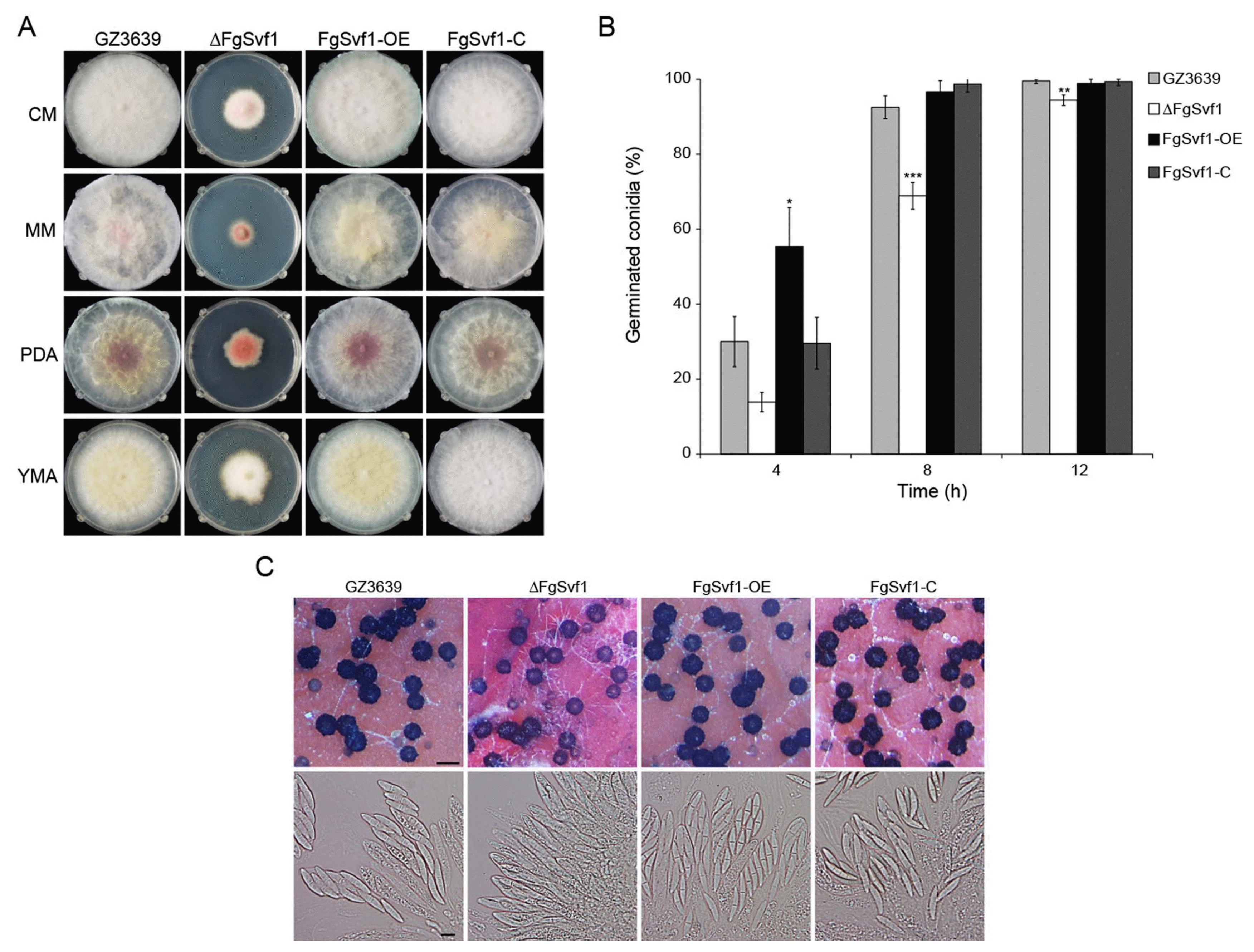
Influence of FgSvf1 on Fusarium graminearum morphology. (A) Influence of FgSvf1 on vegetative growth. GZ3639, ΔFgSvf1, FgSvf1-OE, and FgSvf1-C were grown on complete medium (CM), minimal medium (MM), potato dextrose agar (PDA), and yeast malt agar medium (YMA) at 25°C for 4 days. (B) Influence of FgSvf1 gene on conidia germination. Conidia were inoculated into potato dextrose broth, and the cultures were shaken at 200 rpm at 25°C. After 4, 8, and 12 h of incubation, the conidia were analyzed for germination. Asterisks indicate significant differences (*P < 0.05, **P < 0.01, ***P < 0.001) based on the Tukey’s test in the program R. (C) Involvement of FgSvf1 in sexual development. Each strain was inoculated onto carrot agar for 8 days, and then sexual reproduction was induced by placing the cultures under a near ultraviolet lamp at 25°C. After 10 days, self-fertilization was examined using a dissection microscope. Upper: black, ball-like structures are perithecia. Scale bar = 1 mm. Lower: asci rosettes of each strain were observed microscopically 10 days after sexual induction. Scale bar = 10 μm.
FgSvf1 is responsible for normal conidia germination and sexual reproduction
Compared to the wild-type and complementation strains, conidial germination was delayed in ΔFgSvf1. Although there was no difference of germinated conidia rate between wild-type and ΔFgSvf1 at 4 h, ΔFgSvf1 showed significantly reduced germinated rate after 8 h. Even after 12-h incubation, 6% of conidia from ΔFgSvf1 did not germinate. Conidia germination in FgSvf1-OE increased at 4 h, but after that it is similar to the wild-type strain (Fig. 2B).
Both ΔFgSvf1 and FgSvf1-OE produced perithecia and the numbers of perithecia produced by both mutants did not differ from the wild-type strain. Although ΔFgSvf1 produced perithecia, the normal maturation of ascospore was dismissed in deletion mutant even after 10 days. There was no difference in ascospore maturation between FgSvf1-OE and the wild-type strain (Fig. 2C).
FgSvf1 is required for FHB disease progression on wheat heads and is involved in resistance to various stresses
Bleaching was only shown on the spikelet inoculated with ΔFgSvf1 conidia, and FHB symptoms did not progress to the adjacent spikelets, whereas inoculation of wheat heads with the wild-type GZ3639 and complementation strain conidia caused serious FHB symptoms (Fig. 3). In the cold stress test, ΔFgSvf1 showed a significantly lower survival rate at low temperature than the wild-type strain, but FgSvf1-OE and FgSvf1-C did not differ from the wild-type strain (Fig. 4A). ΔFgSvf1 also displayed reduced resistance to the fungicide prochloraz, whereas FgSvf1-OE showed increased resistance to the prochloraz when compared to the wild-type strain (Fig. 4B). ΔFgSvf1 also displayed reduced resistance to osmotic stresses of 1.0 to 1.8 M NaCl compared with the wild-type strain, but showed increased vegetative growth on media containing 0.2 M and 0.6 M NaCl when compared to the medium without NaCl. FgSvf1-OE showed similar resistance to osmotic stress as the wild-type strain (Fig. 4C). ΔFgSvf1 displayed reduced sensitivity to extracellular oxidative stress, whereas FgSvf1-OE showed increased sensitivity (Fig. 4D). In addition, ΔFgSvf1 showed reduced vegetative growth on PDA (Fig. 2A), except NaCl addition of 0.2 M NaNO3, KCl, or KNO3 to PDA also partially reversed the vegetative growth defect of ΔFgSvf1 (Fig. 5).
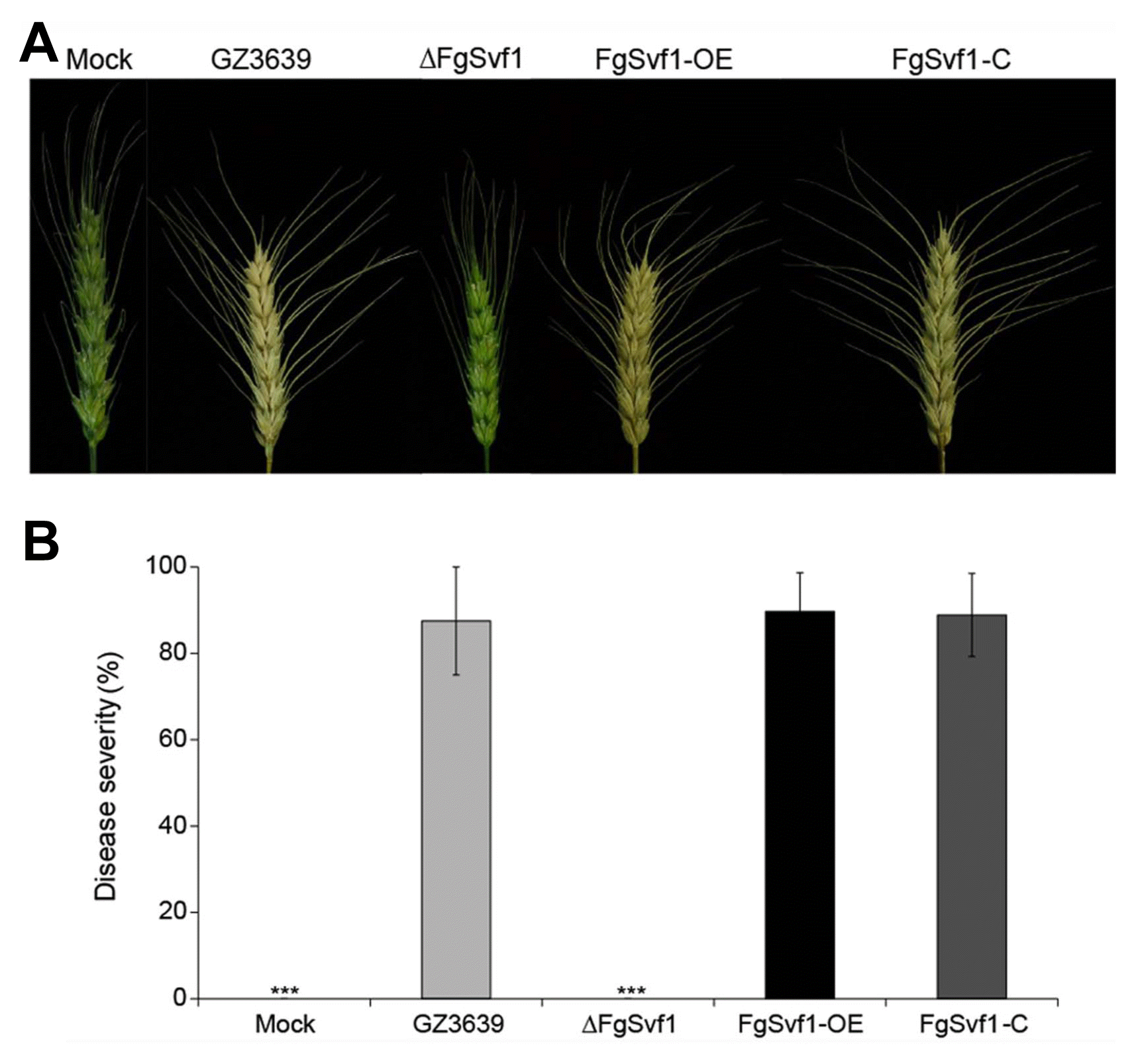
Impact of the FgSvf1 deletion on virulence of Fusarium graminearum. (A) Wheat heads were point inoculated with distilled water (mock) or a conidial suspension of GZ3639, ΔFgSvf1, FgSvf1-OE, or FgSvf1-C. Infected wheat heads were examined 14 days after inoculation. (B) Disease severity of inoculated wheat. Wheat heads were point inoculated with distilled water (mock) or a conidial suspension of GZ3639, ΔFgSvf1, FgSvf1-OE, or FgSvf1-C. Total and infected wheat heads were counted 14 days after inoculation. Asterisks indicate data that differed significantly (***P < 0.001) based on the Tukey’s test in the program R. All data was obtained from three biological replicates.
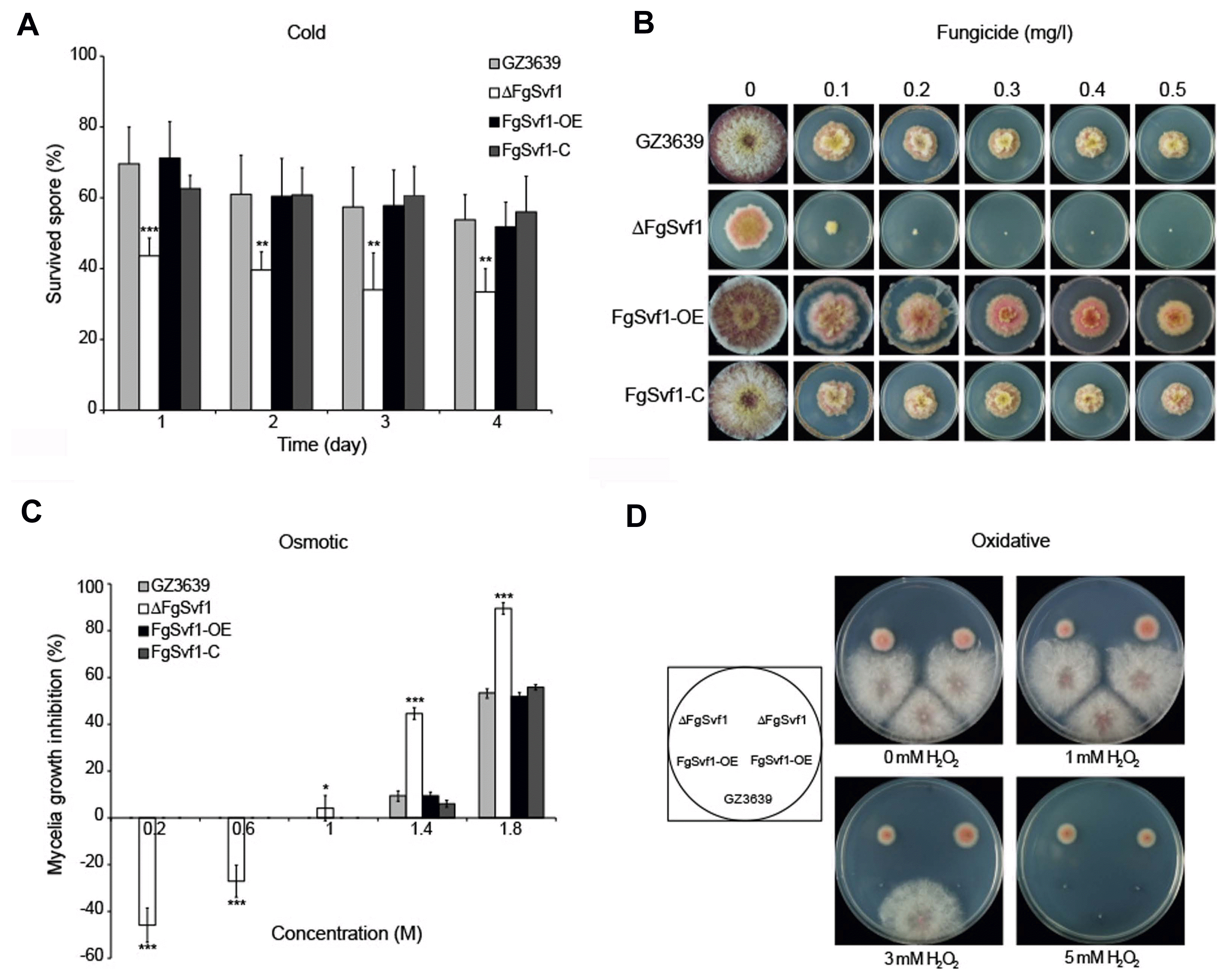
Influence of FgSvf1 on resistance to the cold, a fungicide, osmotic stress, and sensitivity to oxidative stress. (A) Survival of GZ3639, ΔFgSvf1, FgSvf1-OE, and FgSvf1-C under cold stress. 103 conidia/ml of conidia were stored at 4°C for 1–4 days in distilled water. Then 100 μl of each suspension was spread onto potato dextrose agar (PDA) and the survived spore was measured after 3 days. The bar denotes the standard error from five experiments. (B) Resistance to the fungicide prochloraz. GZ3639, ΔFgSvf1, FgSvf1-OE, and FgSvf1-C were inoculated onto PDA containing 0.1–0.5 mg/l prochloraz for 7 days at 25°C. (C) Resistance to osmotic stress. GZ3639, ΔFgSvf1, FgSvf1-OE, and FgSvf1-C were inoculated onto PDA containing 0.2–1.8 M NaCl for 7 days at 25°C. The bar denotes the standard error from three experiments. (D) Sensitivity to oxidative stress. GZ3639, ΔFgSvf1, and FgSvf1-OE were inoculated onto PDA containing 0–5 mM H2O2 for 3 days at 25°C. Asterisks indicate significant differences (*P < 0.05, **P < 0.01, ***P < 0.001) based on the Tukey’s test in the program R.
FgSvf1 is involved in glycolysis
ΔFgSvf1 showed reduced vegetative growth on media that contained glucose or sucrose as the sole carbon source. To confirm the relationship between FgSvf1 and glycolysis, we used two different carbon sources: glycerol, which is utilized by the glycolytic pathway, and olive oil, which is utilized by glycolytic and other pathways. The vegetative growth defect of ΔFgSvf1 was completely recovered on the medium containing olive oil, but not on media containing glucose or glycerol, indicating that FgSvf1 is involved in the normal glycolytic pathway (Fig. 6).

Influence of the carbon source on the vegetative growth of the FgSvf1 deletion mutant. GZ3639, ΔFgSvf1, FgSvf1-OE, and FgSvf1-C were grown on complete medium (CM) medium containing 30 g/l glucose, 30 ml/l glycerol, or 30 ml/l olive oil as the sole carbon source for 7 days at 25°C. CM medium without an added carbon source was used as the control (None).
Quantification of PEP, glycolysis gene transcription, and intracellular ROS levels
ΔFgSvf1 and FgSvf1-OE showed highest and lowest PEP concentration, respectively, but there was no difference in the FgSvf1-C and ΔFgSvf1 strains (Fig. 7A). The transcript levels of genes involved in glycolysis differed among strains. The transcript level of the gene encoding enolase (Zhang et al., 1997), pyruvate kinase (Gupta and Bamezai, 2010) and pyruvate dehydrogenase complex (Izard et al., 1999) were reduced in ΔFgSvf1, but increased in FgSvf1-OE (Fig. 7B). Addition of 30 mM sodium pyruvate to PDA recovered vegetative growth of ΔFgSvf1 (Fig. 7C). ΔFgSvf1 and FgSvf1-OE showed the highest and lowest concentrations of intracellular ROS, respectively. There was no difference in intracellular ROS concentrations when ΔFgSvf1 and FgSvf1-C were compared (Fig. 8).
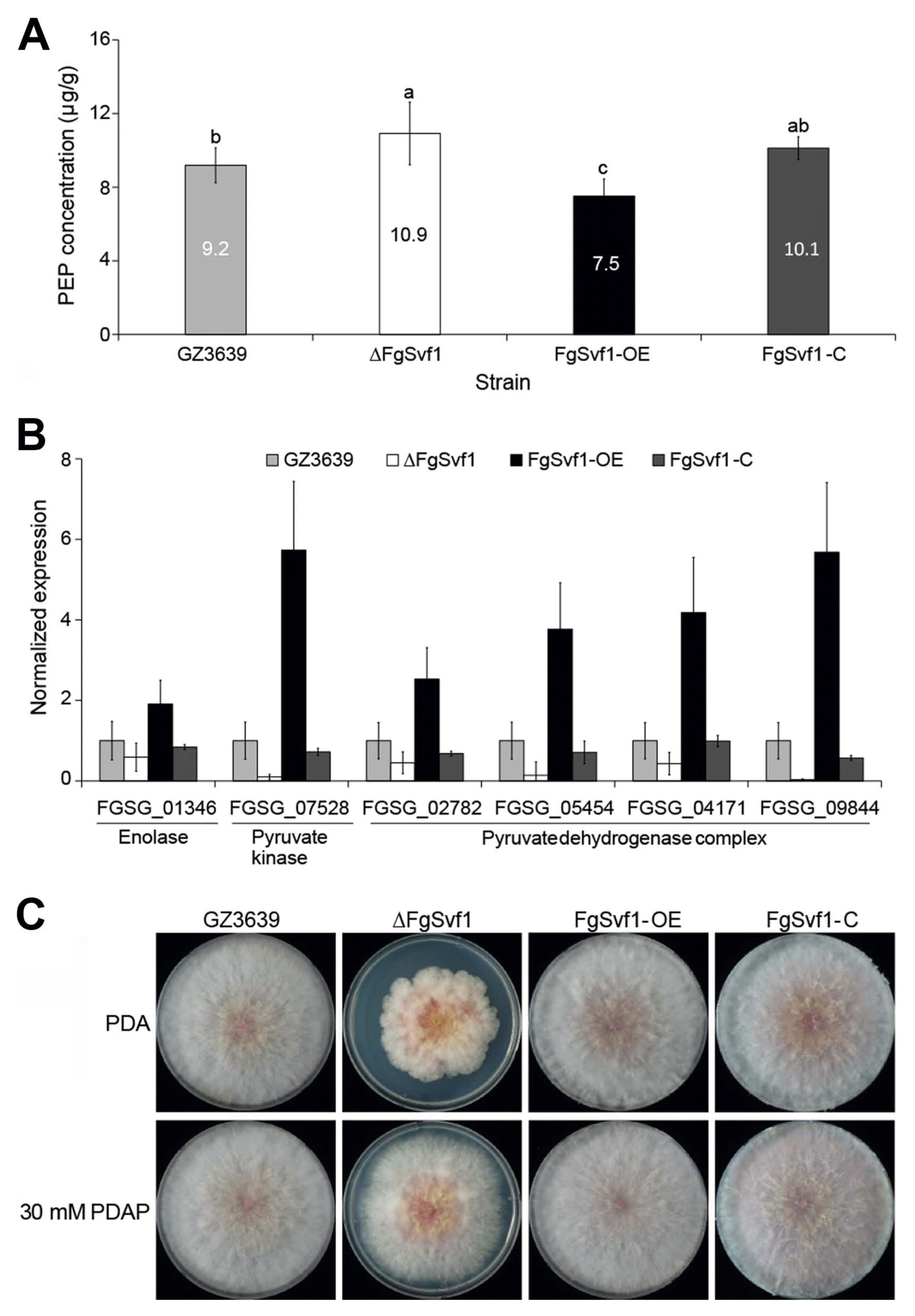
Influence of FgSvf1 on phosphoenolpyruvate (PEP) production and expression of glycolytic genes. (A) PEP concentration in GZ3639, ΔFgSvf1, FgSvf1-OE, and FgSvf1-C. Mycelia were cultivated on potato dextrose agar (PDA) for 7 days, harvested, vacuum freeze-dried, and then PEP was extracted from 0.02 g of dried mycelia from each strain. All data were obtained from two biological replicates. Values with different letters are significantly different according to the Tukey’s test (P < 0.05) in the program R. (B) Normalized expression levels of genes coding enolase, pyruvate kinase, and the pyruvate dehydrogenase complex. RNA was extracted after cultivating each strain in PDA for 7 days. The bar denotes the standard error from three repeated experiments. Gene expression level were normalized to CYP gene expression. (C) Vegetative growth on medium containing sodium pyruvate. Three-day old cultures of GZ3639, ΔFgSvf1, FgSvf1-OE, and FgSvf1-C were cultivated on PDA containing 30 mM of sodium pyruvate for 7 days at 25°C.
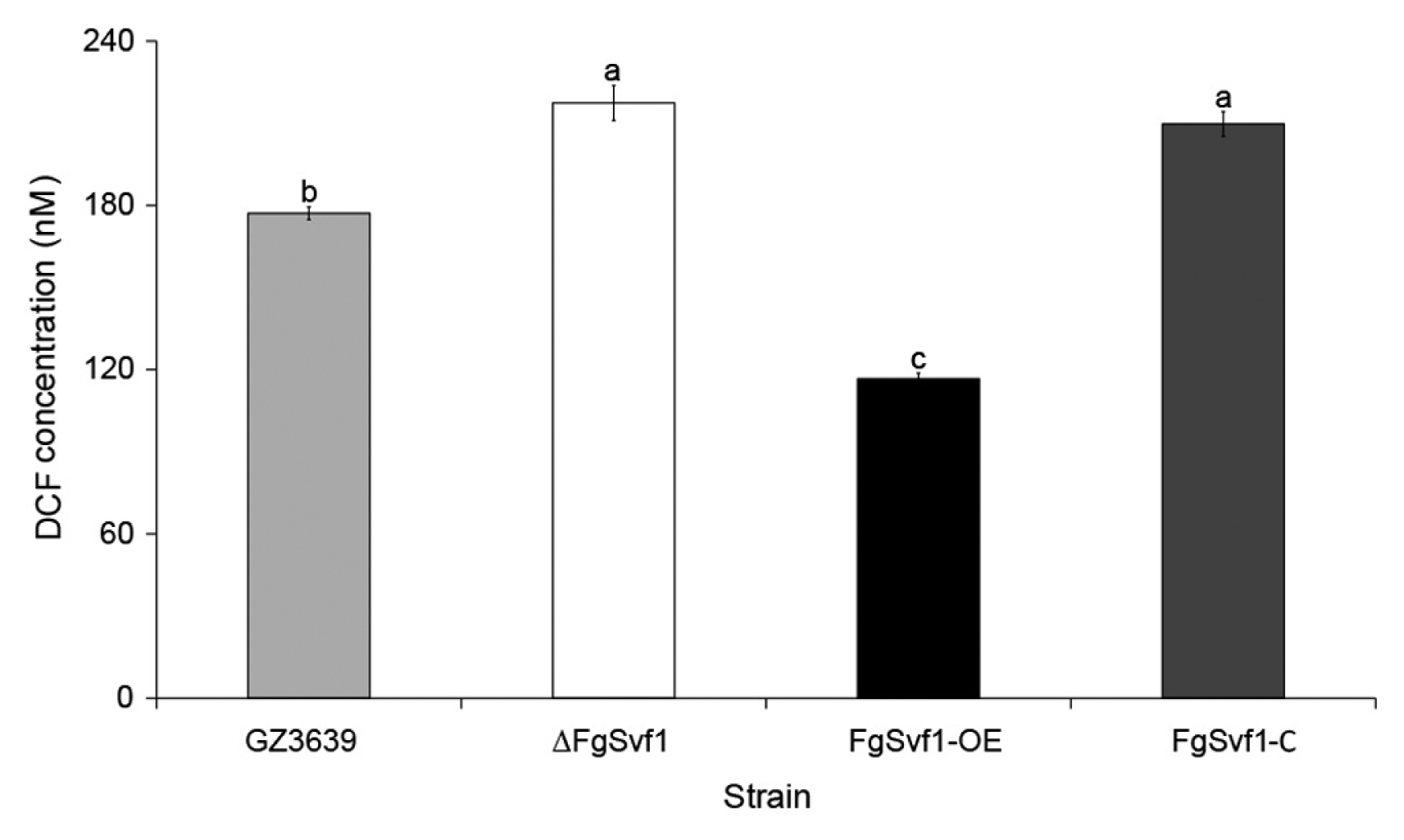
Influence of FgSvf1 on intracellular reactive oxygen species (ROS) production. Four-day-old cultures of GZ3639, ΔFgSvf1, FgSvf1-OE, and FgSvf1-C were cultivated on PDA for 7 days at 25°C. Mycelia were harvested and used to detect intracellular ROS by an ROS kit and fluorescence measurements. DCF, 2′,7′-dichlorofluorescein. Values with different letters are significantly different according to the Tukey’s test (P < 0.05) in the program R. The intracellular ROS concentration of each strain was normalized to the DNA content in each strain.
Discussion
Our characterization of the functions of FgSvf1 in F. graminearum showed that deletion of FgSvf1 led to various alterations, including a delay in conidia germination, a loss of pathogenicity to the host, and defective sexual development. Several of the phenotype changes caused by the deletion of FgSvf1 are similar to the phenotypes of loss-of-function Svf1 and Bcl-xL mutants in S. cerevisiae (Brace et al., 2005; Vander Heiden et al., 2002). For instance, ΔFgSvf1 displayed reduced resistance to cold stress and decreased sensitivity to oxidative stress. Interestingly, the responses to oxidative stress caused by the deletion of Svf1 and FgSvf1 mutants were opposite in S. cerevisiae and F. graminearum. Based on our results, we hypothesized that FgSvf1 like Bcl-xL is involved in the switch from glycolysis to oxidative metabolism for the production of adenosine triphosphate (ATP), which influences vegetative growth (Gramaglia et al., 2004; Vander Heiden et al., 2009).
ΔFgSvf1 showed reduced vegetative growth on medium supplemented with glucose or sucrose, which are the preferred carbon sources for metabolism by glycolysis (Fig. 2A). However, this phenotype was recovered with the addition of salt (Fig. 5) and with olive oil as the carbon source (Fig. 6). Phosphofructokinase phosphorylates fructose 6-phosphate during glycolysis and is inhibited strongly by PEP, but this inhibition has been shown to be relieved by the addition of salts, such as NaCl and KCl (Turner et al., 1980). In this study, we found that the transcript level of the gene encoding enolase was downregulated in ΔFgSvf1 compared to the wild-type strain. However, the PEP concentration was highest in ΔFgSvf1. On the contrary, the transcript level of the gene encoding enolase in overexpression mutant was highest, but the PEP concentration was lowest in the strain (Fig. 7).
The down-regulation of pyruvate kinase transcript in ΔFgSvf1 causes higher PEP accumulation compared to the wild-type, even though the gene encoding enolase, which converts 2-phosphoglycerate to PEP, was downregulated in ΔFgSvf1. The accumulation of PEP in ΔFgSvf1 might inhibit phosphofructokinase and result in the reduced vegetative growth compared to the wild-type strain. The reduced vegetative growth was recovered by adding salt to the medium, which relieves the inhibition of phosphofructokinase. On the other hand, the lowest PEP concentration appeared in FgSvf1-OE might owe to high transcript level of gene encoding pyruvate kinase.
Further, the genes encoding the pyruvate dehydrogenase complex were highly upregulated in the overexpression mutant and the deletion mutant was opposite (Fig. 7B). Abnormal expression of the genes encoding pyruvate kinase and the pyruvate dehydrogenase complex affect the conversion of PEP to pyruvate and the conversion of pyruvate to acetyl-CoA, a downstream metabolite, respectively (Cai et al., 2011). Thus, olive oil, which can be directly converted to acetyl-CoA without going through glycolysis, recovered the vegetative growth of ΔFgSvf1 (Fig. 6).
Reactive oxygen species, such as hydrogen peroxide and superoxide, are produced intracellularly through multiple mechanisms and have multiple functions in an organism. At low levels, ROS exert beneficial effects, such as cell proliferation and differentiation, whereas excessive accumulation of ROS causes deleterious effects, such as DNA damage and PCD. In this study, ΔFgSvf1 displayed reduced sensitivity to oxidative stress and grew on medium containing 5 mM hydrogen peroxide, whereas the wild-type and overexpression mutants did not (Fig. 4D). ΔFgSvf1 had a higher intracellular ROS concentration than the wild-type and overexpression strains (Fig. 8). According to a previous study, exogenous ROS override the cellular oxidative defense system result in oxidative stress (Prasad et al., 2017; Ray et al., 2012). Thus, the higher intracellular ROS concentration in ΔFgSvf1 may have led to the reduced sensitivity to exogenous oxidative stress compared to the wild-type strain. In contrast, the overexpression mutant was more sensitive to oxidative stress. Further, the accumulation of intracellular ROS may have negatively influenced vegetative growth, and this negative effect may have been reversed by the addition of olive oil (Jung et al., 2018).
ΔFgSvf1 also showed decreased resistance to cold stress and fungicide stress. Reduced resistance to cold stress can be caused by multiple factors, such as increased lipid peroxidation, unstable cell wall integrity, and ROS accumulation (Yang et al., 2015). Therefore, the cold stress sensitivity shown in ΔFgSvf1 may be directly related to the accumulation of intracellular ROS. Prochloraz is an inhibitor of lanosterol 14α-demethylase, which is necessary for the production of ergosterol, an essential component of the fungal cell membrane (Darbre, 2015). Moreover, intracellular ROS accumulation can disrupt membrane integrity (Su et al., 2009); thus, the decreased resistance of ΔFgSvf1 to prochloraz may be a result of ROS accumulation.
Fusarium graminearum can survive for a long time under extreme conditions, such as low temperature and limited water and oxygen levels (Leplat et al., 2012). In this study, we demonstrated that FgSvf1 contributes to the ability of F. graminearum to withstand cold, osmotic, oxidative, and fungicide stresses, and contributes to F. graminearum pathogenicity and sexual reproduction. The loss of pathogenicity in ΔFgSvf1 could be due to the reduction in vegetative growth and the altered responses to stresses. FgSvf1 plays an important role in regulating the response to ROS, which is a well-known and common plant defense response. Thus, understanding the function of FgSvf1 may provide new ways to control F. graminearum infections in fields. This study expands our understanding of the diauxic growth shift in filamentous fungi, and further studies will focus on interactions between FgSvf1 and enzymes involved in the regulation of glycolysis and the accumulation of ROS in F. graminearum.
Acknowledgments
This work was supported by the National Research Foundation of Korea (NRF) grant funded by the Korean government (2016R1D1A1B03934439) and the Strategic Initiative for Microbiomes in Agriculture and Food, Ministry of Agriculture, Food and Rural Affairs, Republic of Korea (918019-4).



